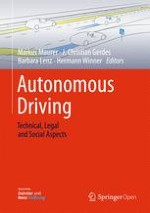Open Access 2016 | Open Access | Buch

Autonomous Driving
Technical, Legal and Social Aspects
herausgegeben von: Markus Maurer, J. Christian Gerdes, Barbara Lenz, Hermann Winner
Verlag: Springer Berlin Heidelberg
Open Access 2016 | Open Access | Buch

herausgegeben von: Markus Maurer, J. Christian Gerdes, Barbara Lenz, Hermann Winner
Verlag: Springer Berlin Heidelberg
This book takes a look at fully automated, autonomous vehicles and discusses many open questions: How can autonomous vehicles be integrated into the current transportation system with diverse users and human drivers? Where do automated vehicles fall under current legal frameworks? What risks are associated with automation and how will society respond to these risks? How will the marketplace react to automated vehicles and what changes may be necessary for companies?
Experts from Germany and the United States define key societal, engineering, and mobility issues related to the automation of vehicles. They discuss the decisions programmers of automated vehicles must make to enable vehicles to perceive their environment, interact with other road users, and choose actions that may have ethical consequences. The authors further identify expectations and concerns that will form the basis for individual and societal acceptance of autonomous driving. While the safety benefits of such vehicles are tremendous, the authors demonstrate that these benefits will only be achieved if vehicles have an appropriate safety concept at the heart of their design. Realizing the potential of automated vehicles to reorganize traffic and transform mobility of people and goods requires similar care in the design of vehicles and networks. By covering all of these topics, the book aims to provide a current, comprehensive, and scientifically sound treatment
of the emerging field of “autonomous driving".